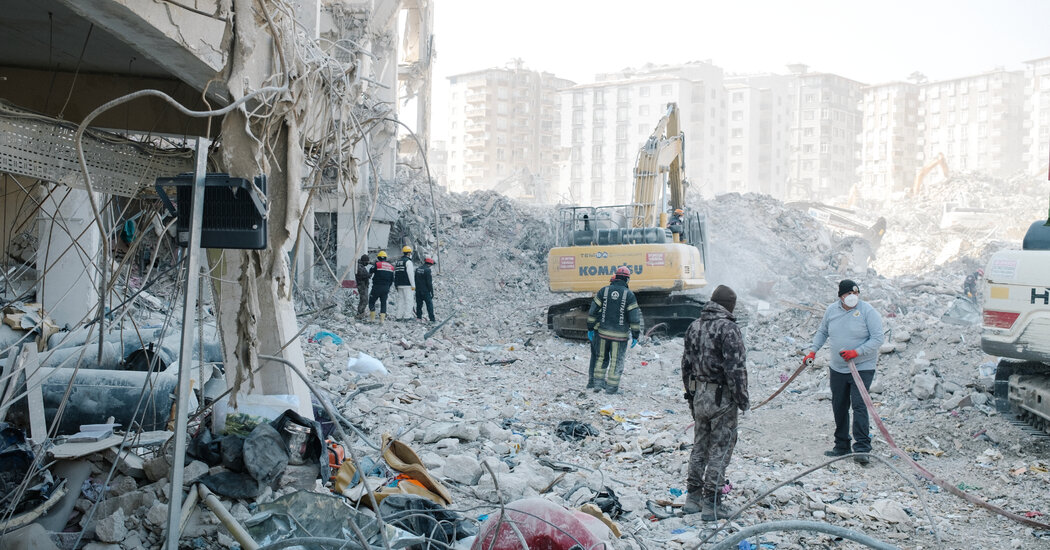The families addressed the court one by one, sobbing as they spoke the names of relatives who had been killed when their upscale apartment complex in southern Turkey toppled over during a powerful earthquake last year.
One woman, whose son had died in the collapse alongside his wife and their 3-year-old son, lashed out at the defendants — the men who had built the complex and the inspectors charged with ensuring that it was safe.
“Shame on you,” said the woman, Remziye Bozdemir. “Your children are alive, mine are dead.”
The hearing on Thursday was the first aimed at seeking accountability for the collapse of Renaissance Residence, one of the most catastrophic building failures during the earthquakes of Feb. 6, 2023, which damaged hundreds of thousands of structures and killed more than 53,000 people across southern Turkey.
More than 300 people died inside Renaissance, and many more were wounded. An investigation and forensic analysis by The New York Times found that a tragic combination of poor design and minimal oversight had left the building vulnerable, ultimately causing its 13 stories to smash into the earth.
Since the quakes, the anger of many survivors has centered on the lax construction practices that allowed so many defective buildings to rise across a region with a history of powerful temblors. When the ground shook last year, many structures became death traps, pancaking down on their residents and killing them instantly or trapping them alive inside the rubble.
In recent months, Turkish courts have begun hearing cases seeking to assign responsibility for the deadly collapses. The Renaissance trial is one such case, which illustrates what victims’ advocates say are the limits of post-quake justice.
Eight men — four from the construction company and four employees of a private building-inspection firm — stand accused of causing foreseeable death and injury through negligence for their roles in the construction of the complex. All eight have pleaded not guilty.
Missing from the case are any of the numerous public officials who allowed the complex to be built by zoning the land, approving building plans and issuing construction permits, together failing to ensure that the project had been constructed to withstand violent quakes.
This scrutiny of private builders but not of public officials has marred efforts to ensure accountability across the quake zone, said Emma Sinclair-Webb, the Turkey director for Human Rights Watch.
“Contractors can be cowboy builders, building defective buildings, but what about the enabling environment in which they operate and the public authorities that turn a blind eye and let them go ahead?” she said.
Complicating efforts to hold such officials accountable is a Turkish law that prevents prosecutors from investigating state employees without obtaining government permission.
It remains unclear whether any public officials are on trial in earthquake-related cases.
In January, Human Rights Watch and Citizens’ Assembly, a Turkish rights group, filed requests in dozens of jurisdictions seeking information about how many requests to investigate public officials had been made and how many had been granted. Their queries turned up four instances in which decisions were pending and three in which permission to investigate had been granted, although two of those had been appealed, the groups said in a report last month.
Most jurisdictions declined to respond, citing confidentiality regulations.
This diminishes the chances for true accountability, Ms. Sinclair-Webb said.
“The full facts are not really there to be looked at if the public officials are left out of the picture,” she said.
Renaissance Residence rose on a patch of converted agricultural land near the ancient city of Antakya during a construction boom that was sweeping through the area in the 2010s, fueled by the plans of Turkey’s leader, Recep Tayyip Erdogan, for development and economic growth. By the time residents arrived in 2013, the three apartment towers, superficially joined to appear as one long, thin building, loomed over the countryside.
The complex catered to the area’s rising middle class, with a pool, underground parking and a lobby designed to mimic that of a hotel. Many early occupants considered themselves lucky to live there.
But The Times’s investigation found that, despite its air of glamour, Renaissance was rife with risky design choices that were cast in concrete with minimal oversight, leaving the structure ill prepared to withstand a powerful earthquake.
The first such quake stuck last year, with a magnitude of 7.8, followed by a second powerful temblor hours later. The first quake caused the ground floor of Renaissance to fail, making the building topple on its side and destroying many of its residents’ lives.
Cemile Incili, 59, a real estate agent who attended the hearing on Thursday, said she had survived the collapse with some injuries but had been able to hear her nephew trapped in the rubble.
“Aunt, I can’t breathe,” she recalled him saying.
His body, and that of a sister of Ms. Incili, were never recovered from the wreckage. She assumes they are dead.
She hoped the trial would mean long sentences for the men who built Renaissance as well as for the officials who allowed the building to rise.
“The state did not protect our lives or our property,” she said.
Court documents say that 269 people have been identified as having been killed in the building and that 46 others are still missing and assumed to be dead.
Prosecutors have charged the eight defendants with conscious negligence that caused multiple deaths and injuries. If convicted, they could face up to 22 years in prison.
The prosecutors have accused the contractors who built Renaissance of failing to follow the building codes in place at the time, using substandard materials and neglecting to ensure that the structure was sound. They have accused the inspectors, who worked for a private company hired by the contractors, of failing to detect flaws that should have been reported to the authorities.
The contractor who was the construction company’s lead architect, Mehmet Yasar Coskun, told the court on Thursday that he rejected the allegations. He blamed the collapse on the exceptional power of the earthquake’s shaking at the site.
“As the foundation of the building was strong, the wave demolished it from the weakest point it could find, the ground floor,” he said. “It is an atypical situation.”
Other defendants, too, said they had followed all the necessary regulations and attributed the collapse to the earthquake’s strength.
Their arguments failed to convince the survivors who attended the hearing.
Hafize Acikgoz, 42, had made it out of Renaissance alive but lost her husband and three children, who were 16, 21 and 23.
“It is just me left behind,” she said, wiping away tears. “Nothing can sooth my pain and nothing can bring them back.”
Still, she hoped that the accused would receive the longest possible sentences.
“Shouldn’t those buildings have been built considering people’s lives?” she said.
Beril Eski contributed reporting from Istanbul.



